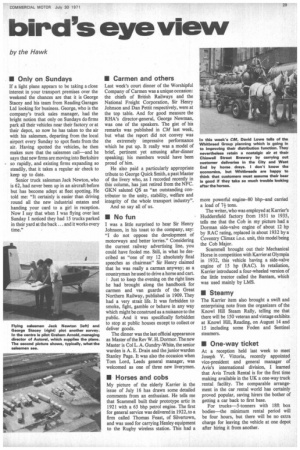bird's eye view
Page 31

If you've noticed an error in this article please click here to report it so we can fix it.
by the Hawk • Only on Sundays
If a light plane appears to be taking a close interest in your transport premises over the weekend the chances are that it is George Stacey and his team from Reading Garages Ltd looking for business. George. who is the company's truck sales manager, had the bright notion that only on Sundays do firms park all their vehicles near their factory or at their depot, so now he has taken to the air with his salesmen, departing from the local airport every Sunday to spot fleets from the air. Having spotted the vehicles, he then makes sure that the salesmen call—and he says that new firms are moving into Berkshire so rapidly, and existing firms expanding so steadily, that it takes a regular air check to keep up to date.
Senior truck salesman Jack Newton, who is 62, had never been up in an aircraft before but has become adept at fleet spotting. He told me: "It certainly is easier than driving round all the new industrial estates and handing your card to a girl in reception. Now I say that when I was flying over last Sunday I noticed they had 15 trucks parked in their yard at the back ... and it works every time."
• Carmen and others
Last week's court dinner of the Worshipful Company of Carmen was a unique occasion: the chiefs of British Railways and the National Freight Corporation, Sir Henry Johnson and Dan Pettit respectively, were at the top table. And for good measure the RHA's director-general, George Newman, was one of the speakers. The gist of his remarks was published in CM last week, but what the report did not convey was the extremely impressive performance which he put up. It really was a model of brief, pertinent yet amusing after-dinner speaking; his members would have been proud of him.
He also paid a particularly appropriate tribute to George Quick Smith, a past Master of the livery who, as I recorded recently in this column, has just retired from the NFC. GKN saluted QS as "an outstanding contributor to the unity, stability, welfare and integrity of the whole transport industry".
And so say all of us.
• No fun
I was a little surprised to hear Sir Henry Johnson, in his toast to the company, say: "I do not oppose the development of motorways and better lorries." Considering the current railway advertising line, you could have fooled me. Still, in what he described as "one of my 12 absolutely final speeches as chairman" Sir Henry claimed that he was really a carman anyway; as a countryman he used to drive a horse and cart.
Just to keep the evening on the right lines he had brought along the handbook for carmen and van guards of the Great Northern Railway, published in 1909. They had a very strait life. It was forbidden to smoke, fight, gamble or behave in any way which might be construed as a nuisance to the public. And it was specifically forbidden to stop at public houses except to collect or deliver goods.
The dinner was the last official appearance as Master of the Rev W. H. Dormor. The new Master is Col L. A. Gundry-White, the senior warden is A. E. Drain and the junior warden Stanley Page. It was also the occasion when Tom Lord, Leeds general manager, was welcomed as one of three new liverymen.
• Horses and cobs
My picture of the elderly Karrier in the issue of July 16 has drawn some detailed comments from an enthusiast. He tells me that Scammell built their prototype artic in 1921 with a 63 bhp petrol engine. The first for general service was delivered in 1922, to a firm called Thomas Feast, of Silvertown, and was used for carrying Henley equipment to the Rugby wireless station. This had a more powerful engine-80 bhp—and carried a load of 7+ tons.
The writer, who was employed at Karrier's Huddersfield factory from 1931 to 1935, tells me that the Cob in my picture had a Dorman side-valve engine of about 12 hp by RAC rating, replaced in about 1932 by a Coventry Climax i.o.e. unit, this model being the Cob Major.
Scammell brought out their Mechanical Horse in competition with Karrier at Olympia in 1932, this vehicle having a side-valve engine of 15 hp (RAC). In retaliation, Karrier introduced a four-wheeled version of the little tractor called the Bantam, which was used mainly by LMS.
• Steamy
The Karrier item also brought a swift and enterprising note from the organizers of the Knowl Hill Steam Rally, telling me that there will be 150 veteran and vintage exhibits at Knowl Hill, Reading, on August 14 and 15 including some Foden and Sentinel steamers.
• One-way ticket
At a reception held last week to meet Joseph V. Vittoria, recently appointed vice-president and general manager of Avis's international division, I learned that Avis Truck Rental is for the first time making available in the UK a one-way truck rental facility. The comparable arrangement in the car rental world has certainly proved popular, saving hirers the bother of getting a car back to first base.
For trucks-5-tonners with 18ft box bodies—the minimum rental period will be four hours, but there will be no extra charge for leaving the vehicle at one depot after hiring it from another.




















































































